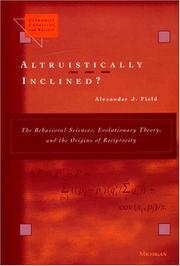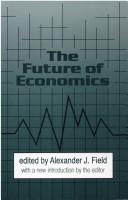| Listing 1 - 10 of 21 | << page >> |
Sort by
|
Book
ISBN: 0898382173 9401079676 9400932693 Year: 1987 Publisher: Boston
Abstract | Keywords | Export | Availability | Bookmark
 Loading...
Loading...Choose an application
- Reference Manager
- EndNote
- RefWorks (Direct export to RefWorks)
World history --- Economics --- -Economic History --- AA / International- internationaal --- 331.100 --- Economic conditions --- History, Economic --- Economic theory --- Political economy --- Social sciences --- Economic man --- History --- Economische geschiedenis: algemeenheden. --- Economic history. --- History. --- Economic history --- Economische geschiedenis: algemeenheden
Book
ISBN: 9780300188165 0300188161 Year: 2011 Publisher: New Haven (Conn.) Yale University Press
Abstract | Keywords | Export | Availability | Bookmark
 Loading...
Loading...Choose an application
- Reference Manager
- EndNote
- RefWorks (Direct export to RefWorks)

ISBN: 0472112244 9780472112241 Year: 2004 Publisher: Ann Arbor, Mich. University of Michigan Press
Abstract | Keywords | Export | Availability | Bookmark
 Loading...
Loading...Choose an application
- Reference Manager
- EndNote
- RefWorks (Direct export to RefWorks)
Microeconomics --- Reciprocity (Psychology) --- Reciprocity (Psychology). --- Altruism --- Genetic psychology --- Social groups --- Altruism. --- Genetic psychology. --- Social groups.

ISBN: 1560007656 Year: 1995 Publisher: New Brunswick (N.J.) : Transaction publishers,
Abstract | Keywords | Export | Availability | Bookmark
 Loading...
Loading...Choose an application
- Reference Manager
- EndNote
- RefWorks (Direct export to RefWorks)
Economic history. --- Economics --- History.
Book
Year: 2013 Publisher: Cambridge, Mass. National Bureau of Economic Research
Abstract | Keywords | Export | Availability | Bookmark
 Loading...
Loading...Choose an application
- Reference Manager
- EndNote
- RefWorks (Direct export to RefWorks)
Digital
Year: 2013 Publisher: Cambridge, Mass. National Bureau of Economic Research
Abstract | Keywords | Export | Availability | Bookmark
 Loading...
Loading...Choose an application
- Reference Manager
- EndNote
- RefWorks (Direct export to RefWorks)
This paper examines the interwar housing cycle in comparison to what transpired in the United States between 2001 and 2011. The 1920s experienced a boom in construction and prolonged retardation in building in the 1930s, resulting in a swing in residential construction's share of GDP, and its absolute volume, that was larger than what has taken place in the 2000s. In contrast, there was relatively little sustained movement in the real price of housing between 1919 and 1941, and the up and down price movements were remarkably modest, certainly in comparison with more recent experience. The paper documents the higher degree of housing leverage in 2001-2011. And it documents a rate of foreclosure on residential housing post 2006 that is likely higher than during the 1930s. It concludes that balance sheet problems resulting from a prior residential housing boom pose greater obstacles to recovery today than they did in the interwar period.

ISBN: 1282765620 9786612765629 0472027263 9780472027262 0472112244 9780472112241 9780472089475 0472089471 Year: 2001 Publisher: Ann Arbor University of Michigan Press
Abstract | Keywords | Export | Availability | Bookmark
 Loading...
Loading...Choose an application
- Reference Manager
- EndNote
- RefWorks (Direct export to RefWorks)
An exploration of the role of altruism in the discipline of economics
Altruism. --- Genetic psychology. --- Reciprocity (Psychology) --- Social groups.
Book
ISBN: 1283096226 9786613096227 0300168756 Year: 2011 Publisher: New Haven : Yale University Press,
Abstract | Keywords | Export | Availability | Bookmark
 Loading...
Loading...Choose an application
- Reference Manager
- EndNote
- RefWorks (Direct export to RefWorks)
This bold re-examination of the history of U.S. economic growth is built around a novel claim, that productive capacity grew dramatically across the Depression years (1929-1941) and that this advance provided the foundation for the economic and military success of the United States during the Second World War as well as for the golden age (1948-1973) that followed. Alexander J. Field takes a fresh look at growth data and concludes that, behind a backdrop of double-digit unemployment, the 1930's actually experienced very high rates of technological and organizational innovation, fueled by the maturing of a privately funded research and development system and the government-funded build-out of the country's surface road infrastructure. This significant new volume in the Yale Series in Economic and Financial History invites new discussion of the causes and consequences of productivity growth over the last century and a half and on our current prospects.
Book
ISBN: 9780300268577 Year: 2023 Publisher: New Haven : Yale University Press,
Abstract | Keywords | Export | Availability | Bookmark
 Loading...
Loading...Choose an application
- Reference Manager
- EndNote
- RefWorks (Direct export to RefWorks)
Many believe that despite its destructive character, war ultimately boosts long-term economic growth. For the United States this view is often supported by appeal to the experience of the Second World War, understood as a triumph of both production and productivity. Alexander Field shows that between 1941 and 1945 manufacturing productivity actually declined, depressed by changes in the output mix and resource shocks from enemy action, including curtailed access to natural rubber and, on the Eastern Seaboard, petroleum. The war forced a shift away from producing goods in which the country had a great deal of experience toward those in which it had little.
World War, 1939-1945 --- Industrial mobilization --- Manufacturing industries --- Economic aspects --- History --- 1939-1945 --- United States --- Economic conditions
Book
ISBN: 0300276710 9780300276718 0300251025 9780300251029 Year: 2024 Publisher: New Haven (Conn.): Yale university press,
Abstract | Keywords | Export | Availability | Bookmark
 Loading...
Loading...Choose an application
- Reference Manager
- EndNote
- RefWorks (Direct export to RefWorks)
Many believe that despite its destructive character, war ultimately boosts long-term economic growth. For the United States this view is often supported by appeal to the experience of the Second World War, understood as a triumph of both production and productivity. Alexander Field shows that between 1941 and 1945 manufacturing productivity actually declined, depressed by changes in the output mix and resource shocks from enemy action, including curtailed access to natural rubber and, on the Eastern Seaboard, petroleum. The war forced a shift away from producing goods in which the country had a great deal of experience toward those in which it had little. Learning by doing was only a partial counterbalance to the intermittent idleness and input hoarding that characterized a shortage economy and dragged down productivity. The conflict distorted human and physical capital accumulation and once it ended, America stopped producing most of the new goods. The war temporarily shut down basic scientific research and the ongoing development of civilian goods. U.S. world economic dominance in 1948, Field shows, was due less to the experience of making war goods and more to the country's productive potential in 1941.
| Listing 1 - 10 of 21 | << page >> |
Sort by
|

 Search
Search Feedback
Feedback About UniCat
About UniCat  Help
Help News
News